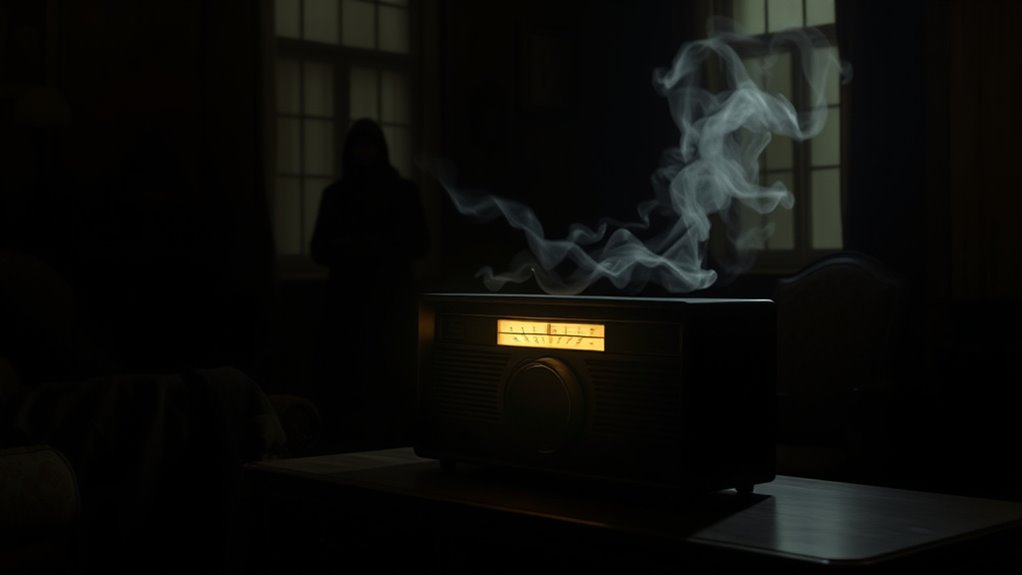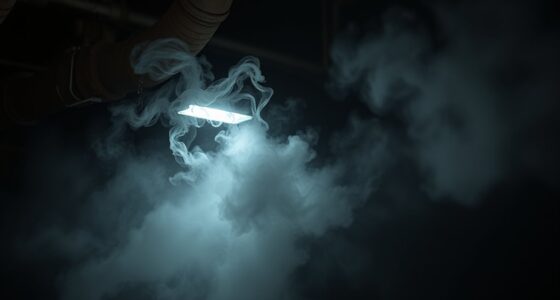Yes, many believe EVPs are often just random radio waves or noise. Skeptics argue that what you hear could simply be auditory pareidolia, where your brain interprets random sounds as speech. While some claim communication from the deceased, the scientific community largely attributes these recordings to interference and environmental factors. It’s important to approach EVP findings critically. If you want to explore the history and techniques behind these phenomena, there’s much more to uncover.
Key Takeaways
- EVP recordings may result from random noise and radio interference, leading to misinterpretations of the sounds captured.
- Auditory pareidolia can cause listeners to perceive speech in random sounds, questioning the authenticity of EVP messages.
- Critics argue that many EVP phenomena can be explained by environmental factors or faulty equipment rather than genuine spirit communication.
- Paranormal experts suggest spirits manipulate electromagnetic fields, yet this claim lacks scientific verification and remains controversial.
- Evaluating EVPs requires distinguishing between Class A and Class C voices, as clarity can be affected by background interference and recording conditions.
Understanding Electronic Voice Phenomena
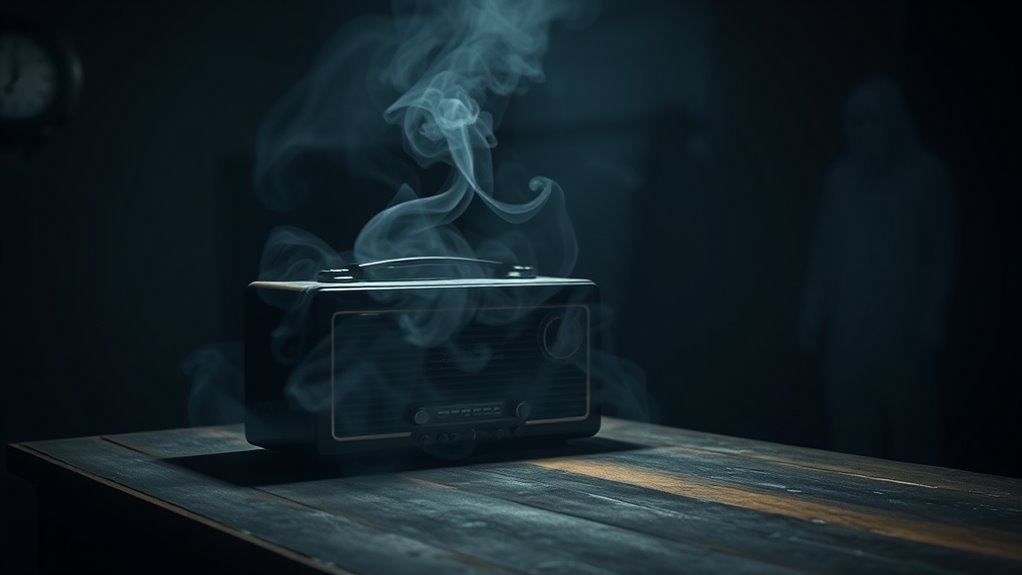
When you explore Electronic Voice Phenomena (EVP), you might find yourself intrigued by the idea that these sounds could be messages from the beyond. EVP involves capturing audio recordings that proponents believe represent attempts at communication with the dead.
Exploring Electronic Voice Phenomena invites curiosity about potential messages from the dead through intriguing audio recordings.
However, skeptics argue that many EVP recordings arise from random noise, like radio interference. This phenomenon can lead to auditory pareidolia, where you might mistakenly interpret random sounds as coherent speech.
Classifications of EVP vary, with Class A voices being clear and easily understood, while Class C voices are often softer and indecipherable.
As you investigate paranormal research, remember that the scientific community remains divided on the validity of EVPs, often attributing these experiences to psychological explanations rather than spirit interaction.
Historical Background of EVP

To understand the origins of EVP, you should look back at early experiments that sought to connect with the spirit world.
Friedrich Jürgenson’s groundbreaking recordings in 1959 marked a significant moment, as he claimed to capture voices of the deceased.
Following him, Konstantin Raudive expanded the field, reporting thousands of recordings that sparked further interest in EVP research.
Early EVP Experiments
Although many might think of EVP as a modern phenomenon, its roots trace back to the late 1950s when Friedrich Jürgenson first recorded what he believed were voices from beyond.
While attempting to capture birdsong, he stumbled upon an electronic voice phenomenon that changed his life. This pioneering work inspired other paranormal researchers, including Konstantin Raudive, who initially approached EVP with skepticism.
Raudive conducted extensive EVP experiments, documenting voices he recorded, including that of his mother, in his book “Breakthrough.”
In 1982, Sarah Estep founded the American Association of Electronic Voice Phenomena (AAEVP) to promote research and understanding of this intriguing field, solidifying early EVP experiments as a significant aspect of paranormal exploration.
Friedrich Jürgenson’s Contributions
Friedrich Jürgenson’s contributions to the field of electronic voice phenomena (EVP) marked a pivotal moment in paranormal research, as he unwittingly captured what he believed were voices from the deceased while trying to record birdsong in 1959.
His EVP recordings revealed messages he claimed were from his deceased parents, igniting interest among paranormal researchers. Jürgenson published two influential books, “Voices From the Universe” and “Radio Contact with the Dead,” detailing his experiences.
He initially wasn’t a paranormal researcher, but his background as a philosopher and linguist shaped his approach. After being advised by a recorded ghost to use radio static, he laid the groundwork for future studies, emphasizing the potential for communication with us from the beyond.
Konstantin Raudive’s Findings
As Konstantin Raudive explored the domain of Electronic Voice Phenomena (EVP) during the 1960s, he made groundbreaking discoveries that would shape the field of paranormal research. Raudive claimed to have recorded over 100,000 voices from the deceased in RF-screened labs, challenging the notion that these were merely random sounds. In his 1968 book, “Breakthrough,” he invited listeners to interpret these recordings, asserting they were genuine spirit communications. His work emphasized the clarity of certain voices, dismissing environmental noise as an explanation.
| Aspect | Raudive’s Findings | Implications |
|---|---|---|
| Number of Recordings | Over 100,000 | Validates EVP research |
| Clarity of Voices | Often clear | Suggests spirit communication |
| Environmental Noise | Minimal interference | Supports genuine findings |
| Publication Year | 1968 | Influences future research |
The Role of Radio Waves in EVP

Radio waves play an essential role in the phenomenon of Electronic Voice Phenomena (EVP), as they can unintentionally interfere with recordings, leading to the capture of unexplained sounds.
Paranormal experts often argue that spirits can manipulate electromagnetic fields, remodulating existing radio waves into coherent speech. However, critics suggest that many EVP recordings result from auditory pareidolia, where your brain interprets random background noise or radio signals as familiar voices.
Devices like the Franks Box, which sweep through radio frequencies in real-time, have sparked debate, as some view them as tools for capturing spirit communication, while others see them as reliant on coincidental radio broadcasts.
Research indicates these EVP messages might simply be artifacts of the recording process rather than evidence of the paranormal.
Natural Explanations for EVP Phenomena
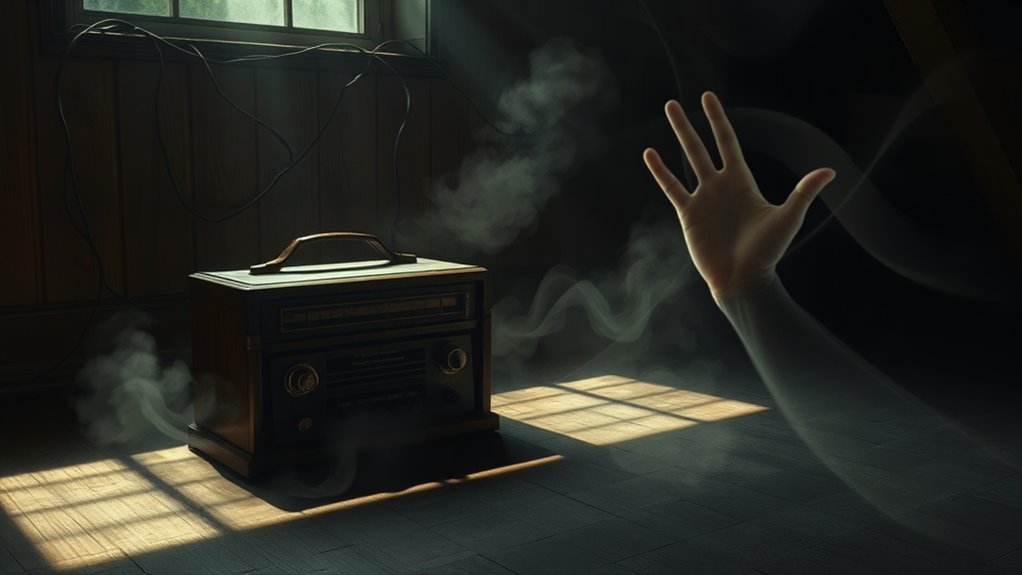
While many enthusiasts believe EVPs are messages from the beyond, natural explanations often provide a more plausible understanding of these phenomena.
Radio interference is a common culprit, as recording equipment can inadvertently pick up signals from nearby transmissions, leading to misinterpretations.
Radio interference can mislead listeners, as recording devices may capture unintended signals from nearby broadcasts.
Auditory pareidolia also plays a significant role; your brain might interpret random noise as recognizable sounds, convincing you that you’ve heard a voice.
Additionally, electromagnetic fields (EMF) are frequently cited by paranormal researchers, suggesting spirits manipulate these fields to imprint voices.
Capture errors due to over-amplification or faulty equipment can produce speech-like artifacts, further complicating EVP validity.
Skeptics argue that environmental factors and technological issues often explain what’s perceived as communication, rather than genuine spirit messages.
Theories on Spirit Communication
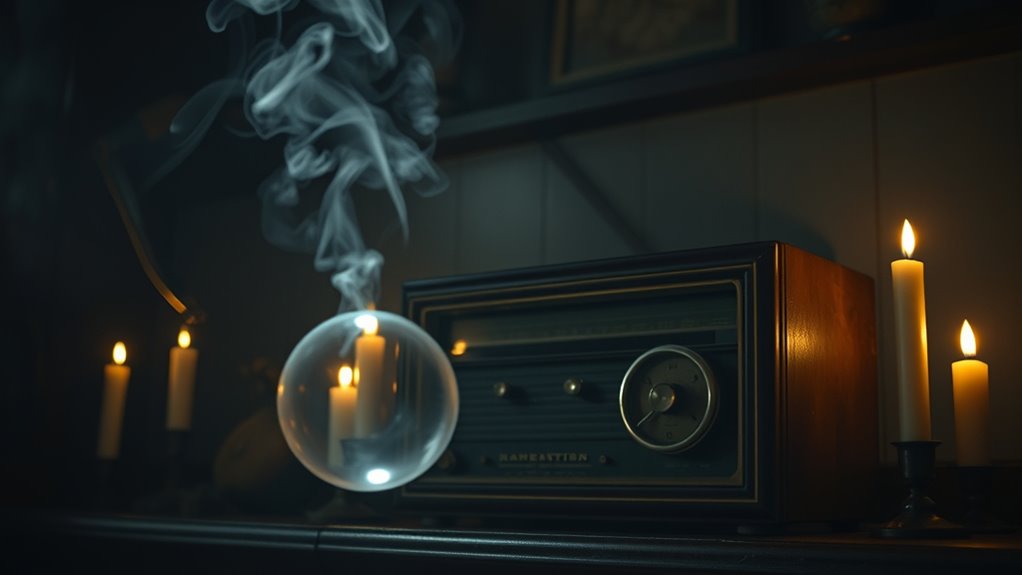
Natural explanations provide a solid foundation for understanding EVP phenomena, but many enthusiasts turn to theories about spirit communication to make sense of these recordings.
Some believe that spirits manipulate electromagnetic fields, imprinting their voices onto recording devices since they exist as pure energy without vocal cords. Paranormal researchers suggest spirits may use radio frequencies to modulate sounds into recognizable speech.
The Interactive Voice Responding (IVR) theory indicates that spirits can respond to your questions, showing conscious intent.
However, critics argue that many EVP recordings result from auditory pareidolia, where your brain interprets random noise as familiar sounds. This skepticism raises important questions about the true nature of spirit communication through electronic voice phenomena.
EVP Research Organizations and Their Contributions
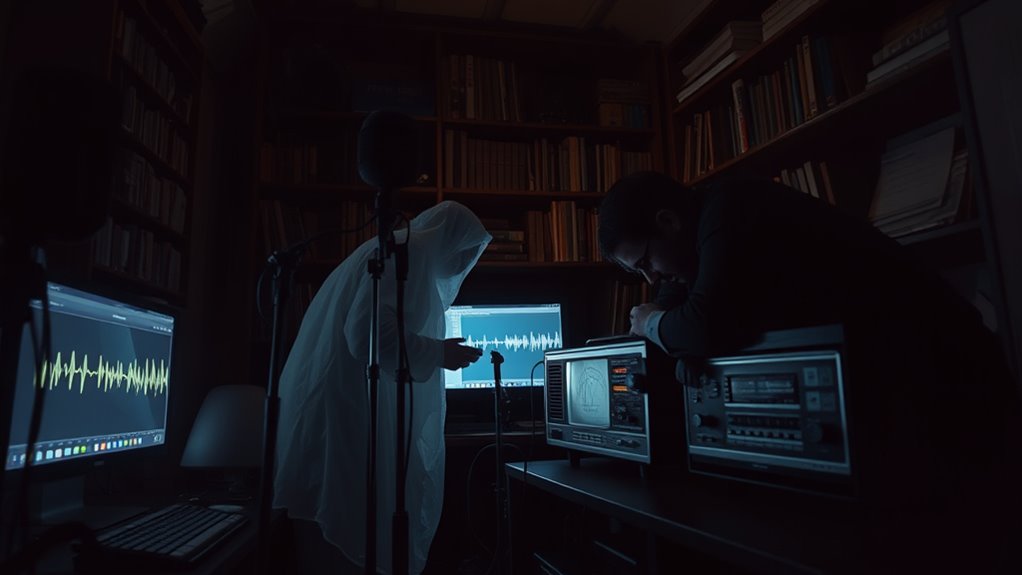
You’ll find that various EVP research organizations have played a vital role in shaping the field.
Groups like the AAEVP and ISPR have conducted significant studies and shared valuable findings that enhance our understanding of EVP.
Their contributions continue to spark interest and debate about the true nature of these mysterious recordings.
Pioneering EVP Research Groups
As researchers explored the mysterious world of Electronic Voice Phenomena (EVP), several pioneering organizations emerged, greatly shaping the field. The American Association of Electronic Voice Phenomena (AAEVP), founded by Sarah Estep in 1982, has been essential in promoting EVP research. Friedrich Jürgenson kickstarted modern EVP studies in the late 1950s, while Dr. Konstantin Raudive further legitimized the field with his extensive recordings.
| Research Group | Key Contributor | Notable Contribution |
|---|---|---|
| American Association of EVP (AAEVP) | Sarah Estep | Platform for sharing EVP research |
| Society for Psychical Research | Various | Qualitative and quantitative research |
| Spiricom Device | William O’Neil | Attempted two-way spirit communication |
Notable EVP Studies Conducted
Notable EVP studies have greatly advanced our understanding of electronic voice phenomena, revealing both the complexities and controversies surrounding the topic.
The American Association of Electronic Voice Phenomena (AAEVP), founded by Sarah Estep in 1982, has been pivotal in promoting research and sharing findings among enthusiasts.
Konstantin Raudive’s extensive work, which included over 100,000 recordings, validated EVP communications in his 1968 book.
Friedrich Jürgenson’s 1959 experiments, attempting to record birdsong, introduced the concept of capturing voices from the deceased.
Imants Barušs’ 1997 study generated 60 hours of recordings but deemed the voices too random for classification, stirring further debate.
Innovations like the Franks Box, created by Frank Sumption in 2002, also fueled interest in EVP research methodologies.
Cultural Impact of EVP in Media
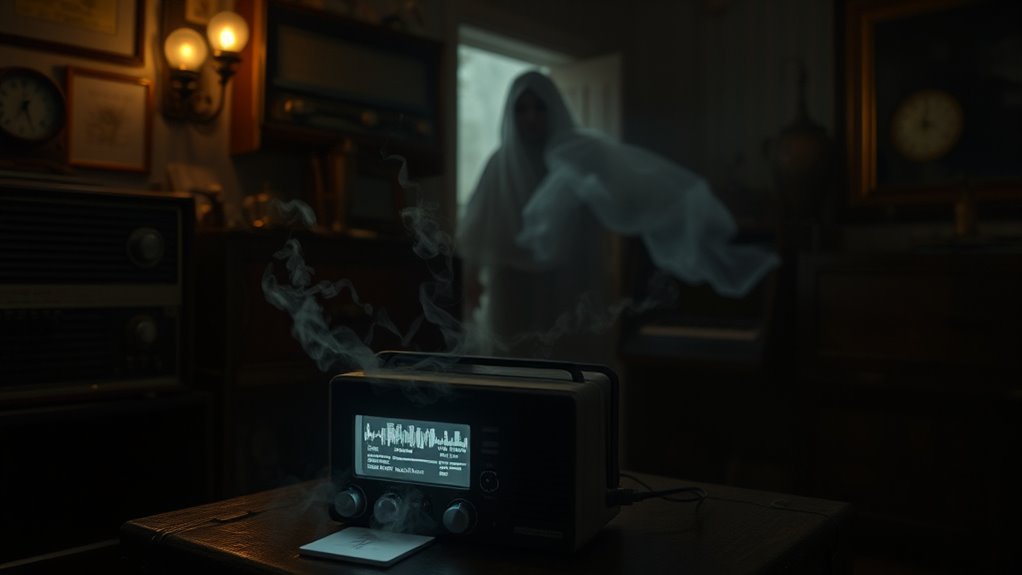
| Medium | Examples | Cultural Significance |
|---|---|---|
| Film | *Poltergeist*, *White Noise* | Communication with spirits |
| Video Games | *Sylvio*, *Phasmophobia* | Interactive spirit engagement |
| Literature | *With the People from the Bridge* | Artistic exploration of EVP |
| Music | *Disembodied Voices on Tape* | Creative expression of paranormal |
| Documentaries | Ghost hunting shows | Societal fascination with EVP |
Techniques for Capturing EVPs

Capturing Electronic Voice Phenomena (EVPs) involves several effective techniques that can greatly enhance the quality of recordings.
As a paranormal investigator, you’ll want to utilize the right tools and methods for the best results. Here are four key techniques:
- Choose the Right Equipment: Use digital voice recorders with external microphones to minimize unwanted sound waves.
- Apply Noise Reduction: Use audio processing software like Audacity to enhance clarity and reduce background noise.
- Cover the Microphone: Employ black electrical tape to lessen human voice interference during recording sessions.
- Use Headphones: Listen carefully during playback; many EVP responses are faint and require focused attention.
Evaluating the Authenticity of EVP Recordings
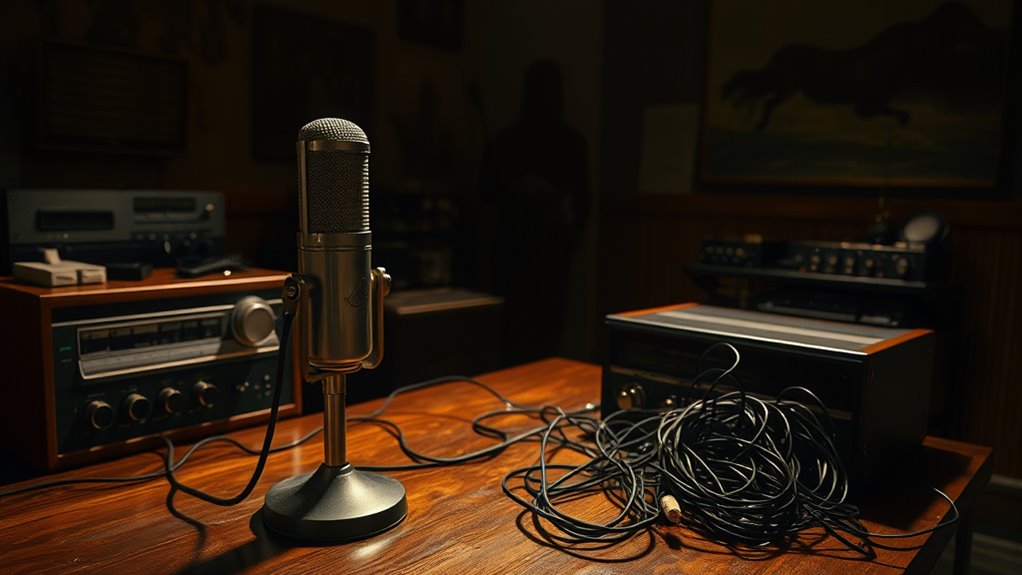
How can you determine if an EVP recording is genuinely capturing a spirit’s voice or just a product of random noise?
To evaluate authenticity, consider the clarity of the EVP. Class A recordings are clearer than Class C, which often sounds indecipherable.
Evaluate the clarity of EVPs; Class A recordings offer clearer messages than the often indecipherable Class C.
Skeptics argue many EVPs result from auditory pareidolia, where your brain interprets random noise as speech. Controlled experiments show that background sounds and radio interference can drastically impact perceived quality.
Without solid scientific evidence supporting two-way communication through devices like the Franks Box, many recordings remain questionable.
Always approach EVPs critically, weighing the possibilities of coincidence against your desire for communication with the beyond.
Frequently Asked Questions
Are EVP Recordings Real?
When you consider EVP recordings, you’re diving into a murky debate. Some people believe these sounds are genuine communications from spirits, while others argue they’re just random artifacts.
You might hear different languages or clear voices, but skeptics suggest that auditory pareidolia plays a role, leading you to interpret noise as speech.
Without controlled studies, it’s tough to determine if these recordings are real or simply coincidental audio occurrences. The mystery remains!
How Do EVP Devices Work?
EVP devices capture sound, convert it into electrical signals, and store it for analysis.
They scan radio frequencies, creating white noise that some believe spirits can manipulate.
You’ll find that using external microphones enhances clarity, while software like Audacity allows you to reduce noise and analyze waveforms.
Where Was the First Ever EVP Recorded?
The first-ever EVP was recorded in 1959 by Friedrich Jürgenson while he was trying to capture birdsong.
Instead, he stumbled upon voices that he didn’t hear at the time of recording. This unexpected discovery took place in Sweden and marked a pivotal moment in paranormal research.
Jürgenson claimed he recognized the voices of his deceased parents, igniting a fascination with EVP that continues to intrigue researchers and enthusiasts around the world today.
Are Radio Waves Really Waves?
You’d think radio waves are just fluffy, invisible things floating around, huh?
But in reality, they’re very much waves! They travel through space at light speed, showing off wave-like properties like reflection and diffraction.
These characteristics let them navigate obstacles and transmit signals over vast distances.
Conclusion
In summary, while the mystery of Electronic Voice Phenomena might leave you pondering, it’s essential to reflect on the compelling combination of technology and the unknown. Whether you find solace in the spirit stories or skepticism in the static, EVP continues to spark fascination. As you explore this enigmatic echo, remember that every eerie encounter invites inquiry and ignites imagination. So, stay curious and keep listening, because the world of EVP is a thrilling tapestry of the unexplained!
